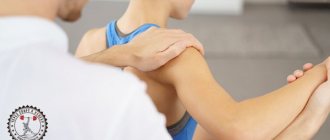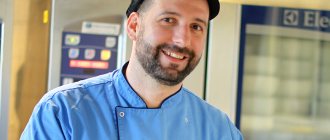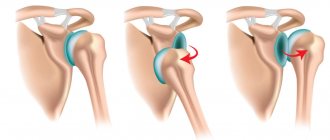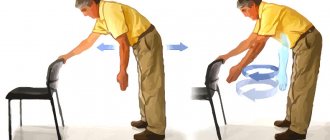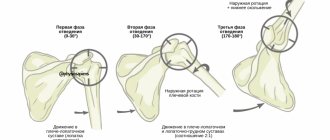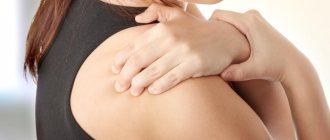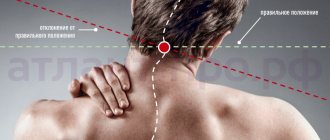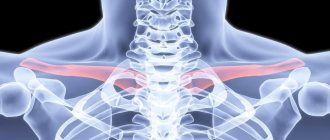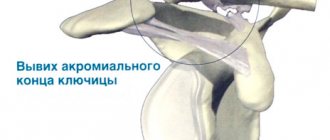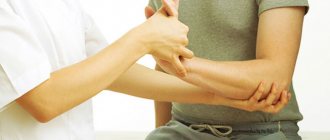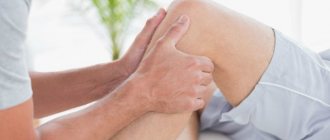In our clinic you can undergo comprehensive rehabilitation after treatment for shoulder instability.
For more detailed information and to schedule a consultation, call us at
A dislocated shoulder is one of the most serious sports injuries. With rough reduction of a dislocation, without pain relief; fixing the shoulder with a bandage instead of plaster immobilization; its duration is less than 3 weeks and, most importantly, in the absence of professional rehabilitation, chronic instability of the shoulder joint may develop in the form of repeated subluxations and dislocations. Especially often, in 80% of cases, habitual shoulder dislocation develops after a primary dislocation in young athletes.
Rehabilitation during the period of immobilization (up to 3 weeks after surgery).
Our observations show that low quality of rehabilitation or its absence are the main risk factors for recurrent postoperative subluxations or dislocations of the shoulder. Rehabilitation begins immediately after surgery and goes in parallel with medical measures. Its objectives are to relieve inflammation, promote the regeneration of damaged tissues, and stimulate the paraarticular muscles of the PS. Cryotherapy is performed: a cold pack is applied to the surgical site for 15-20 minutes, 5-7 times a day.
To speed up the repair process and prevent postoperative complications, the athlete is given special drugs - enzymes - in the first two weeks Flogenzym, then Wobenzym. Several times a day, the patient performs isometric tension of the paraarticular muscles for 5-7 seconds, with pauses for relaxation of 3-4 seconds. The duration of exercises for each muscle group (flexors, extensors, abductors, adductors and externally and internally rotating the shoulder) is until fatigue, the degree of tension is maximum, but does not cause pain. Exercises are performed using the elbow or hand resting on the hand of the exercise therapy instructor, the patient himself or any hard surface. In addition, dynamic exercises are performed - rotation of the shoulder girdles and reduction of the shoulder blades, exercises for the hand and fingers.
Rehabilitation after cessation of immobilization (4-8 weeks after surgery).
The objectives of rehabilitation are:
- Training of PS stabilizer muscles;
- Restoration of movements in the joint in all planes (flexion, extension, abduction, adduction, internal and external rotation).
The main means of rehabilitation is kinesitherapy: therapeutic exercises, exercises using simulators, physical exercises in the pool. Auxiliary means are massage and physiotherapy (myoelectric stimulation, magnetic therapy). In the first days of the exercise therapy room, lightweight exercises for the joints are performed with a gradual increase in amplitude: rocking, shoulder abduction with sliding on a smooth panel, etc. Shoulder movements must be performed in the sagittal, transversal, frontal and rotational planes. To speed up the recovery of movements, exercises using simulators are gradually added: on the “steering wheel” simulator, rotational movements are performed, gently increasing shoulder flexion; on the “ski pole” simulator - abduction in the transversal plane; with the help of rubber shock absorbers – abduction in the frontal plane.
Technique for rhythmic stabilization of the shoulder joint.
The rate of elimination of joint contracture should not be forced. Stretching and jerking exercises are excluded. External rotation is performed with extreme caution, because this movement is stressful for the glenoid. Weak, untrained muscles are a risk factor for recurrent shoulder dislocation, which is why strengthening them in the postoperative period is so important. This is especially true for athletes, especially in sports with stressful loads on the PS. The active stabilizers of the shoulder joint are the paraarticular muscles. The main stabilizers of the shoulder joint are the infraspinatus, teres major, teres minor, and subscapularis muscles, the tendons of which, woven into the capsule of the shoulder joint, form the so-called rotator cuff. The deltoid, biceps and triceps brachii muscles are also involved in stabilizing the shoulder joint.
Dynamic exercises are performed to train muscle strength endurance. Their working amplitude should be 5-100 less than the maximum possible, so as not to damage the cartilaginous lip, capsule and ligaments. This principle is observed throughout all further stages of the athlete’s rehabilitation. Already in the first days after the cessation of immobilization, exercises for the rotator muscles with a small amplitude are performed with an elastic rubber bar. The most lightweight version of external rotation with weights (dumbbell weighing 1-2 kg) is performed in IP. sitting, resting your elbow on your thigh or on the surface of the table with a minimum amplitude of shoulder flexion. As the amplitude of active movements in the joint increases, rotation of the shoulder is performed when it is flexed or abducted at an angle of 80-900, while the shoulder rests on a special roller. The amount of burden and resistance also increases.
9-11 weeks after surgery.
Rehabilitation after arthroscopy of the shoulder joint.
By 9-10 weeks, the range of motion in the joint increases significantly, which allows the use of more complex and effective exercises for muscle training. For this purpose, such exercise machines as “trapeze”, “vertical arm press”, etc. are used. To train the muscles of the rotator cuff, exercises are performed not only with flexion and abduction, but also with extension of the shoulder. Exercises are done with weights or with a rubber shock absorber. Movements such as throwing the ball from behind the head in handball, or hitting the ball with a racket in tennis and badminton cannot be performed with weakened muscles of the scapula, so it is necessary to train the serratus anterior, rhomboid major and minor and trapezius muscles, which stabilize the scapula and control its coordination movements with the muscles of the shoulder girdle.
An important role is played by exercises for the development of proprioception, which “guides” the balanced actions of the entire muscle ensemble. This is especially important for the stability of the PS when performing complex movements. When performing such exercises, proprioceptors located in the rotator cuff are stimulated. An example of such an exercise is push-ups with your hands supported on a destabilizing surface, for example using a BÓsu mini-simulator. Training of the muscles of the shoulder girdle continues using the analytical method (separately for each muscle or muscle group), as well as for the entire muscle ensemble of the shoulder girdle and interscapular muscles (for example, pull-ups on the bar). First, for about 7-10 days, pull-ups are performed in a mixed hang, then in a pure hang.
12-15 weeks after surgery.
This is the final period of rehabilitation, after which the patient or athlete can begin the initial stage of training under the guidance of a trainer. The rehabilitation program includes simulation and auxiliary exercises that correspond to the athlete’s specialization. Proprioceptive training plays an important role in the rehabilitation of patients, especially in those sports where the PS is exposed to stressful loads, for example, tennis, badminton, volleyball, and martial arts. Exercises are used to improve coordination of the muscles of the shoulder girdle and scapula. These are sports-oriented, simulating basic exercises in a particular sport. They are performed at a slow or medium pace, with moderate muscle tension, with an incomplete range of motion in the joint, so they are safe. At the same time, they ensure coordinated work of the entire muscle ensemble and contribute to the psychological rehabilitation of athletes.
The criteria for admitting an athlete to the initial stage of training are:
- Absence of clinical symptoms at rest and when performing special exercises;
- Restoring the full range of motion in the joint in all planes;
- No atrophy of the muscles of the shoulder girdle;
- A period of at least 3-4 months after surgery for sports that do not place increased demands on PS, such as swimming, cross-country athletics, cycling, cross-country skiing, etc.);
- A period of at least 5-6 months after surgery for athletes under 25 years of age and for sports with stress loads on the PS (martial arts, “top kick or throw” sports - tennis, volleyball, handball, badminton, etc.).
An athlete’s admission to competition must be preceded by a period of full training under the guidance of a coach for at least 1-2 months.
Recovery after a shoulder dislocation
Shoulder mobility not only allows for ease of movement, but also makes it unstable and prone to injury. Treatment and development of the shoulder joint after a dislocation must be timely and under the supervision of a doctor. The cause of damage may be injury, disease or congenital anomaly of the joint, or improper reduction of a previous dislocation.
Symptoms and treatment
The most pronounced symptoms of a shoulder dislocation include severe pain, asymmetry and swelling of the shoulder, limited activity of the joint, and decreased or impaired sensitivity. If a dislocation is detected, it is necessary to stop moving the shoulder, apply cold, if possible, apply a fixing bandage, and immediately consult a doctor. The doctor examines the hand visually and by palpation, and also takes an x-ray.
It is strictly not recommended to reset a dislocated shoulder on your own, as there is a possibility of damage to blood vessels and nerve endings.
If there is no indication for shoulder surgery, then a dislocated shoulder joint is treated by reduction, after which shoulder movement is limited until complete recovery, which takes from one to six months. To do this, a splint or bandage is applied, and a course of physiotherapeutic procedures is prescribed.
Author's methods of massage and exercise therapy
Since ancient times, people have been looking for ways to combat pain and degenerative changes occurring in the tissues of the shoulder joint. Knowledge about the capabilities of the human body is becoming deeper, medical science is developing, and new therapeutic techniques are appearing. Some of them actually prove their effectiveness and become famous.
Dunaev's developments
They say that blind people often become excellent massage therapists. Their fingers are so sensitive that when they touch a person’s body, they “read” it like Braille, feeling every muscle, every joint or ligament, easily identifying changes in them. Igor Vitalievich Dunaev is one of these specialists. The doctor, who once lost his sight, after retraining became a well-known massage practitioner and theorist, describing the use of techniques in the treatment of specific diseases.
The master paid much attention in his works to the shoulder area and its structures. Many diseases begin with the appearance of pain in the joint located here. With glenohumeral periarthritis, they are characterized as shooting or aching and in the first stage of the disease they appear only when turning the shoulder or raising the arms. They can be eliminated using a special massage technique, including impact on the neck, trapezius, shoulder girdle, area of the pectoralis major muscle, and shoulder.
When working on a joint, Dunaev recommends:
- grasping stroking with the palm of the hand;
- rubbing in a spiral, which is performed with four fingers;
- semicircular kneading;
- point circular pressing of the joint surface;
- forceps-like effect.
The master suggests removing severe pain in the structure of the joint reflexively, using a mechanical massager with a semicircular rubber or ebonite head. They massage the paravertebral zone on the affected side, the inner edge of the scapula, the supraspinatus fossa and trigger points of the latissimus dorsi muscle.
Therapeutic gymnastics by Bubnovsky
Sergei Mikhailovich Bubnovsky, a doctor with 30 years of experience, uses kinesitherapy - movement treatment - as the basis for his method of combating diseases of the shoulder joint. The author's program includes special exercises that will help awaken the body's hidden reserves and direct them to restore health.
The simplest complex can be performed independently, at home, strictly following the recommendations of the master:
- We clench and unclench our fists 6-8 times.
- We hug ourselves by the shoulders and take a breath. As we exhale, we raise our arms.
- In a standing position, raise your arms above your head and lower them.
- We pull them back as far as the joint allows, and then hold them in front of us, parallel to the floor.
- We lie on our backs, arms along the body. Trying not to lift our palms from the surface, we raise our shoulders, moving our elbows to the sides.
- In a lying position, place folded hands under your head. Remaining in this position, we try to connect our elbows together.
- After this, we stretch our arms along the body, and while inhaling, we lift them up one by one.
- Sitting on a chair, we draw figure eights with our shoulders in the vertical and horizontal plane, while looking straight ahead without rotating our heads.
- Bringing your hand behind your back from above and then from below, we try to touch the edge of the shoulder blade.
Having mastered the movements, we complicate the task by doing the same with weights. To do this, you will need dumbbells or plastic bottles of water weighing one liter. Exercises with a rubber elastic band bring very good results. We stretch it with outstretched arms forward, across the sides or from behind the head up.
Don’t worry if after the first procedures the joint and surrounding muscles hurt – this is the body’s natural reaction to an unusual load. Gradually, the discomfort will disappear, and the mobility of the joint will increase significantly. Nearby muscles will become elastic and strong.
This is how, step by step, overcoming pain, fear, and sometimes laziness, it becomes possible to cope with unpleasant sensations, stop the disease, say a decisive “no” to physical weakness, and prolong activity and performance for many years.
Why do you need a bandage?
A bandage is a support bandage that helps limit the motion of the shoulder joint after it has been reduced. The main task of the bandage is to protect the arm from sudden conscious or unconscious movements, reduce or completely eliminate pain. The bandage has a compression effect and helps improve nutrition of joint tissue.
According to the method and strength of fixation, bandages are divided into the following types:
- Limiting - increases shoulder stability, provides maximum support, reduces the possibility of arthrosis, and is easy to hide under clothing.
- Supportive - a scarf-type bandage attached to the back. It is used for minor injuries, as it does not ensure complete immobility of the joint.
- Fixing or Deso bandage - rigidly holds the forearm in the desired position, secures not only the shoulder, but also the elbow, which eliminates the possibility of deformation during the rehabilitation process.
Return to contents
A little anatomy
A massage aimed at improving the condition of the most mobile joint includes mandatory work on nearby muscles, which are often mistakenly combined into one group. Actually this is not true.
The shoulder is the part of the arm located between the elbow and shoulder joints. It is based on tubular bone with a heterogeneous surface. Clearly defined tubercles and ridges are the site of attachment of fibers, each of which belongs to one of two muscle groups: anterior or posterior. The anterior one includes three muscles:
- Double-headed: at its beginning it represents completely independent structures. The long one is connected to the supraglenoid tubercle of the scapula by a tendon, the short one originates from the coracoid process. Then both heads merge into a single muscle fiber, which stretches along the entire surface of the shoulder, and is attached at the lower end to the radius bone of the forearm. The job of this structure is to flex the arm as well as externally rotate the shoulder (supinate).
- Coracohumeral: one end is attached to the coracoid process of the scapula, the other to the middle of the humerus. Without this structure, it is impossible to raise and lower the arm, rotate it outward, or bring it toward the body.
- Brachialis: with its wide surface it covers the biceps muscle, attaches to the ulna and serves to flex the forearm.
The posterior group is represented by two muscles:
- Triceps, the individual heads of which are united into a common tendon, participating in the movement and abduction of the lower part of the arm.
- The ulnar is a continuation of the middle head of the triceps structure that extends the forearm.
The bone base of the shoulder girdle consists of two shoulder blades and collarbones, and the muscles - deltoid, supraspinatus, infraspinatus, subscapularis, teres minor and teres major - provide a variety of arm movements.
The joint itself has a unique structure: the spherical head of the humerus is almost 3 times the volume of the bed. This explains the greater mobility of the joint. And its strength is given by muscles, ligaments and a special formation - a lip made of cartilage tissue, which extends beyond the boundaries of the bed, gently enveloping the head.
The joint capsule is dense, spacious, lined from the inside with a synovial membrane that secretes a special lubricant that nourishes the cartilage and ensures free sliding of the structural elements during movement.
Rehabilitation methods after shoulder dislocation
Rehabilitation of the shoulder joint is carried out in 3 stages. At the first stage (duration 1 week), the patient is provided with maximum rest for the injured shoulder. The second lasts from 2 to 4 weeks, minor warm-up movements of the shoulder and joint are allowed. The third - can last up to 6 months, and is aimed at restoring full joint movement and reducing the inflammatory process. At this stage, rehabilitation includes massage, gymnastic and physiotherapy.
Physiotherapeutic procedures
The safest method for any person, as it does not involve drug treatment. With the help of physiotherapy, the immune system is strengthened, biochemical processes and the body's own defenses are mobilized. Physical therapy speeds up recovery and recovery from injury. Physiotherapy procedures are prescribed strictly according to individual indications.
- UHF;
- ultrasound therapy;
- laser therapy;
- electrical stimulation;
- phonophoresis;
- inductometry.
Return to contents
General information about exercise therapy and massage
With the help of therapeutic exercises, you can develop a joint, restore blood and lymph circulation, lost range of motion, and normalize metabolism in an injured limb. To stabilize the joint, it is necessary to strengthen the deltoid muscle, biceps and triceps. Exercises to develop your arm should begin with simple exercises, gradually complicating them. Having increased muscle tone, you can move on to increasing the load. Exercise therapy is performed on both arms and only under the supervision of the attending physician or trainer. If strength exercises are performed incorrectly, re-injury can occur. The goal of massage at the first stage of rehabilitation is to prevent muscle atrophy. In the second and third stages, massage activates metabolism, strengthens the ligamentous apparatus, and restores the functions of movement and performance.
An approximate set of physical exercises that are performed in one starting position - lie on your back, stretch your legs, arms along your body:
- Perform rotational movements with your hands.
- Bend and straighten your fingers.
- Bend/extend your arms at the elbow.
- Alternately raise your arms straight in front of you (support the injured limb with your healthy hand).
- Alternately move your arms to the side (support the injured limb with your healthy hand).
Return to contents
Traditional methods of treatment
In folk medicine, herbs such as bryonia, tansy, and elecampane have long been used to reduce pain. An ointment for massage and rubbing is prepared from bryonia - 1 tsp. pureed bryonia root, pour 100 ml of sunflower oil, boil in a water bath for 2 hours, strain, rub into the shoulder. Tansy and elecampane are used to prepare compresses - pour a glass of boiling water, leave for 60 minutes, strain, cool and apply to the damaged area.
Periarthritis of the shoulder
Periarthritis is inflammation of the tissues surrounding the joint. Most often this is the result of repeated movements of the same type, which lead to tension in the tendons and periosteum. The degenerative process gradually progresses, and signs of reactive inflammation appear.
The most common area where periarthritis develops is the shoulder. In addition, glenohumeral periarthritis is the most common disease of the shoulder joint. Most often, the right limb is affected. This is primarily due to a person’s professional activity.
Main approaches to treatment:
- anesthesia;
- complete functional rest;
- if necessary, immobilizing or limiting mobility bandages;
- physiotherapy;
- massage.
Functional rest alone leads to healing over time. Why, then, do you need a massage? It performs a number of important functions:
- reduces pain;
- eliminates swelling, improves microcirculation, and therefore accelerates the recovery of damaged tendons and muscles;
- prevents muscles from atrophying during the period of their functional rest.
Massage technique for dislocations
Dislocation is a persistent displacement of the ends of bones beyond the boundaries of their normal mobility, often accompanied by hemorrhage. Its consequence is stretching or rupture of the joint capsule and ligaments. The most common dislocations of the upper limb, in particular the shoulder joint. With traumatic dislocations, the patient feels acute pain, especially at first.
You should proceed to massage only after the dislocation has been reduced and a therapeutic method has been applied to immobilize the part of the body where the dislocation is found.
Impact on the shoulder joint should begin with the muscles of the shoulder girdle (upper trapezius muscle and neck muscles). First, you need to use stroking and kneading (single, double ring), and after two to three minutes, move on to concentric stroking of the shoulder joint and kneading the shoulder. Massage should be carried out for 5-7 minutes 2 times a day.
If there is no acute pain, then you can begin direct impact on the joint. First, the anterior, posterior and lower walls of the joint capsule are massaged. To make it more convenient to work, the patient is recommended to place the injured arm (as far as possible) behind his back. Standing behind the patient, the massage therapist simultaneously works on the right and left joints: with his right hand on the right joint, with his left hand on the left. Along with this, various rubbings are used: straight with the pads of four fingers, circular with the pads of four fingers, the base of the palm and the phalanges of the fingers bent into a fist. Rubbing must be used in combination with stroking and kneading.
Massage of the back surface of the joint should be carried out using the same technique as massage of the front surface; The difference is that when providing the effect, the massage therapist must be in front of the patient, and the patient must take a position in which the hand of the affected arm should grasp the elbow joint of the healthy arm.
Massage of the shoulder joint can also be performed in a position where the forearm of the sore arm is on the table. This position makes it possible to relax the shoulder muscles and get deeper into the joint capsule. First of all, you should perform concentric stroking, and then straight and circular rubbing around the joint.
At the end of each massage session, several movements should be made in the joint. To do this, the massage therapist must fix the outer edge of the scapula with one hand, and with the other, holding the distal part of the limb, perform movements in all directions, increasing the amplitude over and over again.
When ligament damage is observed, effusion accumulates in the joint capsule, which then deforms its anterior wall and displaces the patella upward. Massaging should begin from the front of the thigh. After performing a two to three minute preparatory massage, which includes stroking, squeezing, and kneading techniques, you can move on to concentric stroking of the knee joint (to give it an optimal physiological position, you need to place a pillow under the joint). After this, it is recommended to carry out straight-line and circular rubbing with the pads of four fingers and the base of the palm, lasting 2-3 minutes. Particular attention should be paid to the lateral areas of the joint. The patient is recommended to bend his leg at the knee, after which he should continue rubbing the lateral areas with the pads of his thumbs. Rubbing should be done in different directions. Over time, the intensity of the massage should increase.
If you need to massage the back surface of the knee joint, the patient should take a lying position on his stomach and bend his leg at the knee at an angle of 45-75 degrees. Massage should be carried out in the same way as on a healthy joint, taking into account only the patient’s level of pain. Massaging the knee joint should be completed with alternating passive, active and resistance movements (sometimes alternating with rubbing).
Before starting a massage of this area, you need to place a cushion or pillow under the sore leg, and then begin a preparatory massage in the direction from the ankle to the knee (2-3 minutes). In this case, you should use a combination of stroking and squeezing.
Classic massage
Classic medical or therapeutic massage is a universal method of symptomatic and restorative treatment. It is used for pain of any origin. In the absence of significant shoulder damage (bone fractures, ligament tears, inflammatory or degenerative processes), massage alone may be enough to solve the problem.
Begin the massage by affecting the periarticular tissues. The specialist rubs the shoulder girdle, shoulder blade, shoulder. He then makes kneading movements with both hands, which move quickly in opposite directions. By pressing the palms of the hands on the soft tissues, the massage therapist stimulates the outflow of lymph and blood circulation.
Next, light stroking movements are performed again. After which the kneading of individual muscles begins. The shoulder girdle is worked on, and then the shoulder. If it is necessary to eliminate edema, pressing movements are performed in the direction of the distal parts of the upper limb.
Thus, massage for shoulder pain is not limited to affecting only the shoulder joint. The specialist massages:
- shoulder girdle;
- shoulder;
- breast;
- back.
A session lasts on average 20 minutes. In total, you need 10-15 of them to get a sustainable result.
Learn more about recovery techniques
Have you been trying to heal your JOINTS for many years?
Head of the Institute for the Treatment of Joints: “You will be amazed at how easy it is to cure your joints by taking the product every day for 147 rubles .
Our readers successfully use Sustalaif to treat joints. Seeing how popular this product is, we decided to bring it to your attention. Read more here...
Treatment of a dislocated shoulder involves an extensive range of measures aimed at restoring the functions of the shoulder joint. Rehabilitation is mandatory for patients, regardless of the severity of the injury and the duration of immobilization. The main recovery methods are:
- Physiotherapy. This stage is very important on the path to recovery. Exercises to develop the shoulder joint are performed one day after reduction and gradually move on to more complex exercises.
- Massage in combination with other techniques brings undeniable benefits in the form of improved blood circulation, reduction of bruises, swelling and strengthening of muscles and ligaments.
- Physiotherapy: ultrasound, UHF, phonophoresis, electrical stimulation. Physiotherapeutic treatment does not involve the use of medications. It has a positive effect on the damaged joint. Nevertheless, it is worth discussing with your doctor the use of a particular procedure, as there are contraindications.
- Use of orthopedic structures as prescribed by a doctor.
Shoulder massage
- Classic massage
- Damage to muscles and tendons
- Periarthritis of the shoulder
- Shoulder epicondylitis
- Shoulder ligament injuries
- Massage for a dislocated shoulder
- Massage for arthrosis
Massage of the shoulder and surrounding tissues is used for any damage: inflammatory, traumatic, degenerative-dystrophic. This procedure helps reduce pain and improve blood flow, relieve swelling and ensure normal reparative processes. Massage should be performed by an experienced specialist, since it has its own characteristics for different diseases. When severe symptoms appear, it is very important to conduct a diagnosis in order to plan treatment. After all, massage in most cases is used only as an auxiliary technique to normalize recovery and eliminate symptoms. But other methods of therapy are often required for the patient to get a lasting result.
General information about exercise therapy
The use of exercise therapy methods is an integral part of the recovery period. Physical therapy for a dislocated shoulder joint is prescribed from the first day after the reduction has taken place. In this case, reliable fixation of the joint with bandages is necessary, because it is thanks to this that damaged tissues are restored faster. However, the fixation should only apply to the shoulder joint. In other segments of the hand, movements must be performed.
It is necessary to develop the shoulder joint after a dislocation by extending and flexing the fingers, hand, and forearm in the elbow area. A special set of useful exercises has been developed.
- The joint remains motionless - while voluntary tension of specific muscle masses is carried out.
- Contractions accompanied by attempts to make movements in a fixed joint, or active movements that are allowed. These exercises are performed with a healthy and a sore hand in turn.
These physical therapy methods, used after a dislocation, are performed over several weeks while the joint is motionless. After this period ends, wearing a scarf is indicated.
Actions are taken to develop the muscles of the shoulder girdle:
- simple circular shoulder movements, but you only need to move your shoulder upward;
- raising the shoulders;
- scapular information and separation;
- flexion and extension movements in the shoulder joints; a short delay is needed at the extreme points.
The main condition that must be met during the process of recovery and performing a set of exercise therapy exercises after a dislocation is not to remove the scarf from the forearm. After the bandage is removed, the set of exercises expands.
First you need to raise the empty limb. When performing the movements does not bring any painful sensations, dumbbells are placed in the hands. At first, their weight is minimal, but it must be increased gradually. You cannot subject the joint to high loads very early. Because of this, secondary dislocation may occur and it may become habitual.
Contraindications to massaging the shoulder girdle area
You should not consider the procedure only as a way to relieve tension or get pleasant sensations. At the moment when the massage therapist kneads the patient’s shoulders, the entire body is “involved” in the work, the most complex mechanisms aimed at self-regulation and recovery are launched. Such an action can lead to irreversible consequences if a person has a history of:
- severe congenital or acquired pathologies of the structure of the joint or bones;
- serious vascular defects: aneurysms, compression, malformations;
- oncological diseases;
- fresh hematomas;
- swelling;
- acute conditions with bruises, dislocations, fractures;
- the first week after any surgical intervention;
- abscesses;
- serious disorders of lymph flow and blood circulation;
- diseases of the shoulder girdle structures in the acute phase.
A questionable diagnosis is also an absolute contraindication to massaging the shoulder girdle area. Only a doctor can prescribe the procedure. If it is not possible, he will select another, more gentle, but no less effective treatment.
Symptoms and treatment
The most pronounced symptoms of a shoulder dislocation include severe pain, asymmetry and swelling of the shoulder, limited activity of the joint, and decreased or impaired sensitivity. If a dislocation is detected, it is necessary to stop moving the shoulder, apply cold, if possible, apply a fixing bandage, and immediately consult a doctor. The doctor examines the hand visually and by palpation, and also takes an x-ray.
It is strictly not recommended to reset a dislocated shoulder on your own, as there is a possibility of damage to blood vessels and nerve endings.
If there is no indication for shoulder surgery, then a dislocated shoulder joint is treated by reduction, after which shoulder movement is limited until complete recovery, which takes from one to six months. To do this, a splint or bandage is applied, and a course of physiotherapeutic procedures is prescribed.
Return to contents
Causes of shoulder dislocation
According to statistics, this injury is diagnosed in 60% of the total number of dislocations. This is explained by the structure of the movable joint, which allows movements in a wide range and different planes.
The main causes of humerus displacement are:
- High degree of mobility of the shoulder joint;
- Minimum area of connection between joint surfaces;
- Relatively large or thin joint sac;
- Frequent hand injury during a fall.
If the injury was present in the past, then the likelihood of repeated or habitual displacement of the bone increases. This is explained by the fact that during the first injury the joint sac or ligamentous apparatus is torn. Also, a similar problem arises as a result of incorrect treatment of a dislocation.
Features of treatment of dislocation
Getting rid of trauma is a long and complex process. There are several stages of treatment: shoulder reduction, immobilization and rehabilitation therapy.
The diagnosis of shoulder dislocation is not always favorable. However, with high-quality and timely implementation of all stages of treatment for dislocation, it is possible to achieve positive dynamics of the pathology and restore full movement.
According to statistics, young patients in 80% of cases, some time after rehabilitation, receive a repeated or habitual dislocation. Older patients are even more susceptible to this problem.
The reason for the disappointing prognosis is the inability of the articular cartilage tissue to return to its original anatomical position, which does not allow stabilization of the shoulder. If left untreated, repeated cases of dislocation require arthroscopy of the shoulder joint.
This surgical intervention is low-traumatic, and recovery after a dislocation occurs much faster than after a conventional operation.
Surgical treatment is justified in the following cases:
- severe forms of dislocations accompanied by fractures, deformations, injuries;
- separation of the joint capsule, lip (Bankart injury);
- external deformation of the humeral head (Hill-Sachs injury).
When is brachial plexus massage prescribed?
The procedure improves the condition of bone and cartilage components, removing growths and salt deposits, activating blood supply, eliminating spasms, releasing pinched nerve endings, strengthening muscles, ligaments, and tendons.
Indications include problems with the shoulder joint such as:
- osteochondrosis;
- arthrosis;
- arthritis;
- periarthritis;
- neuralgia;
- inflammatory processes of the joint capsule;
- bruises, blows, dislocations;
- sprain;
- soft tissue rupture;
- limited mobility;
- numbness or paresis, including during a stroke;
- bursitis;
- habitual dislocation;
- hematoma;
- swelling;
- rehabilitation after a fracture or arthroscopy - surgical intervention for diagnostic purposes.
Interestingly, a reflex effect can be exerted on the joint by massaging the nearby structures of the shoulder girdle.
As a result:
- muscle fibers relax, become soft, elastic, spasm and tension go away;
- reserve capillaries open in nearby tissues, blood circulation accelerates, thereby improving nutrition of the components of the joint itself;
- lymphatic drainage increases;
- muscles and ligaments are strengthened;
- the development of dystrophic changes in tissues is stopped.
This beneficial effect gives reason to prescribe shoulder massage to adults and children as a preventative measure for diseases and injuries.
Surgical treatment
Treatment of this injury must be timely, since after fourteen days the joint begins to gradually heal, which makes the doctor’s task much more difficult. Reduction of a fresh dislocation is carried out under general or local anesthesia, and upon completion of the procedure, the shoulder is fixed in a certain position.
Statistics show that in approximately 80% of patients the affected arm may be dislocated for the second time. The cause of relapse is the inability of the injured limb to fully recover. Such cases require surgical intervention, namely arthroscopy.
Shoulder surgery is recommended in the following cases:
- There is external deformation of the head of the shoulder joint.
- Dislocation with complications - damage to tendons, nerves, blood vessels, the presence of a fracture.
- If there is a tear of the joint capsule.
Surgery can also serve as one of the ways to strengthen and restore muscle tissue to avoid re-damage.
Shoulder ligament injuries
A rare group of pathologies. This is the result of great mobility of the joint. It is very difficult to perform movements in the shoulder in a volume that is not provided for by the functionality of the shoulder. In addition, there are many muscles around it that protect the bursal-ligamentous apparatus.
But still, sometimes the ligaments of the shoulder joint are completely or partially torn. Swelling, pain with movement, and deformity appear. Shoulder massage after injury is used to reduce pain, swelling, and also to quickly restore joint function.
In the first days after the injury, the swelling is too pronounced. The pain syndrome is also intense. Therefore, direct impact on the shoulder joint is impossible. Massage the tissue nearby. Preference is given to massage techniques that ensure lymph drainage. As the symptoms decrease, or after the plaster splint is removed, a gentle effect on the shoulder joint itself begins. Gradually the intensity can increase. The massage technique and duration of sessions are determined individually, based on the clinical situation and the patient’s feelings.
Sometimes the acromioclavicular joint is torn or stretched. Most often this is the result of a fall, impact or collision with an object at high speed (hockey, road accident). Complete rupture is very rare; most of the time it is partial. Palpation in the area of the shoulder joint becomes painful. Pain appears or intensifies with every movement.
Purposes of massage:
- relieve pain;
- remove swelling;
- provide good conditions for rapid regeneration of the ligament.
Massage is performed for pain in the shoulder joint already in the acute period of injury. During the procedure, the immobilizing bandage is removed. The impact is on the muscles of the back, chest and forearm. Directly in the problem area, only stroking is used. Over time, it is possible to massage this area more vigorously.
